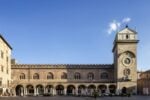Schengen Baroque Pasolini
.jpg)
La Chiesa di San Paolo in Converso, in piazza Piazza S. Eufemia Milan, sede dello spazio Converso, presenta la mostra Schengen Baroque Pasolini a cura di Pierre-Alexandre Mateos e Charles Teyssou.
Comunicato stampa
SCHENGEN
BAROQUE
PASOLINI
CURATED BY PIERRE-ALEXANDRE MATEOS AND CHARLES TEYSSOU 10.01
16.01
2018
Armature Globale
Michel Auder
James Bridle
Lili Reynaud Dewar
Paul-Alexandre Islas
Ken Lum
Gianni Pettena
The Church of San Paolo Converso was erected during the 16th century in order to convert poor young girls into nuns, offering them to transition from two sites of patriarchal power, the family and the church. Named after Saint Paul, a crucial figure in the narrative of the catholic church’s genesis, it was conceived as a technology of conversion that would reproduce, through its immersive baroque architecture, the transcendental experience of Saint Paul’s conversion while on his way to persecute Christian. At the same moment of the church construction, the ideological incubator of modern capitalism, embodied by the protestant dissension, was progressively opening the path for an opposite form of Baroque that will blossom in the secular and ethereal spaces of neo-liberalism. Schengen Baroque Pasolini seeks to confront the anamorphic Baroque that gave birth to San Paolo Converso with the reticular Baroque of the ¥€$ regime. It has now become an understatement to say that we live a new baroque age. We experience a scale of transitions which only equivalence is to be found in the Italian Renaissance. The power regime forged during the Quattrocento that seeks to convert the world into data with the invention of perspective and the banking system has now mutated into planetary scale computation. The colonial powers of the 15th century which financed their expansion with the necro-capitalist regime of slavery have now evolved into an highly complex system of technologies that regulate bodies sexually and racially.
The anachronic confrontation of these two baroque regimes was already staged by Pier Paolo Pasolini in his unrealized film on Saint Paul. Transposing without any modification the dialogues of Saint Paul from the Acts of the Apostles directly into the western geopolitics of the 20th century, the film was a picaresque journey into European bourgeoisie, Greenwich village youngster crowd and Black Panther activists. The original conversion of Saint Paul was replaced in Pasolini’s version by a violent car crash that occurred while he was driving to Barcelona in order to fight the Spanish resistance. Joining the communist resistance instead, the apostle’s odyssey will ultimately lead him to die in the 70s neo-liberal décor of New York. His death is choreographed as a Metropolitan ballet: “martyred in the middle of the traffic, in the suburbs of a large city, a painfully modern city, with all its suspension bridges, its skyscrapers, its crushing, immense crowds that pass by the spectacle of death without stopping, and continue to whirl around him, along their enormous street – indifferent, hostile, senseless.” (Pasolini, Pier Paolo, In Progetto per un film su San Paolo, 1968).
Ultimately, the body is the last fortress against martial authorities, spiritual charlatanism, and reapers of singularities. A body subject of internal tension, itself homogenized by years of disordered saraband, liberated and commodified, manipulated by faustian appeals. A body disenchanted, disposed of its centralities and successively afflicted by narcissistic wounds. A body who is suffering but a resisting one, embracing deserters, margins and another renegades. A body of conversion, dissolution and resurrection. A Pasolinian's one who will prefer risking « a violent life » than to integrate the desolate landscape of the strange machines that collides, not terrified to be part of an apocalypse of the flesh, if flowing and incarnating beyond a world of cement and steel.
Opening: Jan 10, 2019, 6 PM
•
Pierre-Alexandre Mateos (1989) and Charles Teyssou (1988) are a duo of curators based in Paris. They have done a research residency for the LUMA Arles Foundation in 2018. In parallel to this, they recently curated the Cruising Pavilion at the 16th Biennial of Architecture (Venice), an exhibition devoted to the links between sex, art and architecture and What's Up Doc? at the New Gallery (Paris). They have been the editor of L'Officiel Art and are regular contributors of Flash Art, Mousse and Cura. They are currently working on curated screening of films by Jack Smith at the Fondation Van Gogh in Arles as well as the continuation of the Cruising Pavilion in New York and Stockholm.



